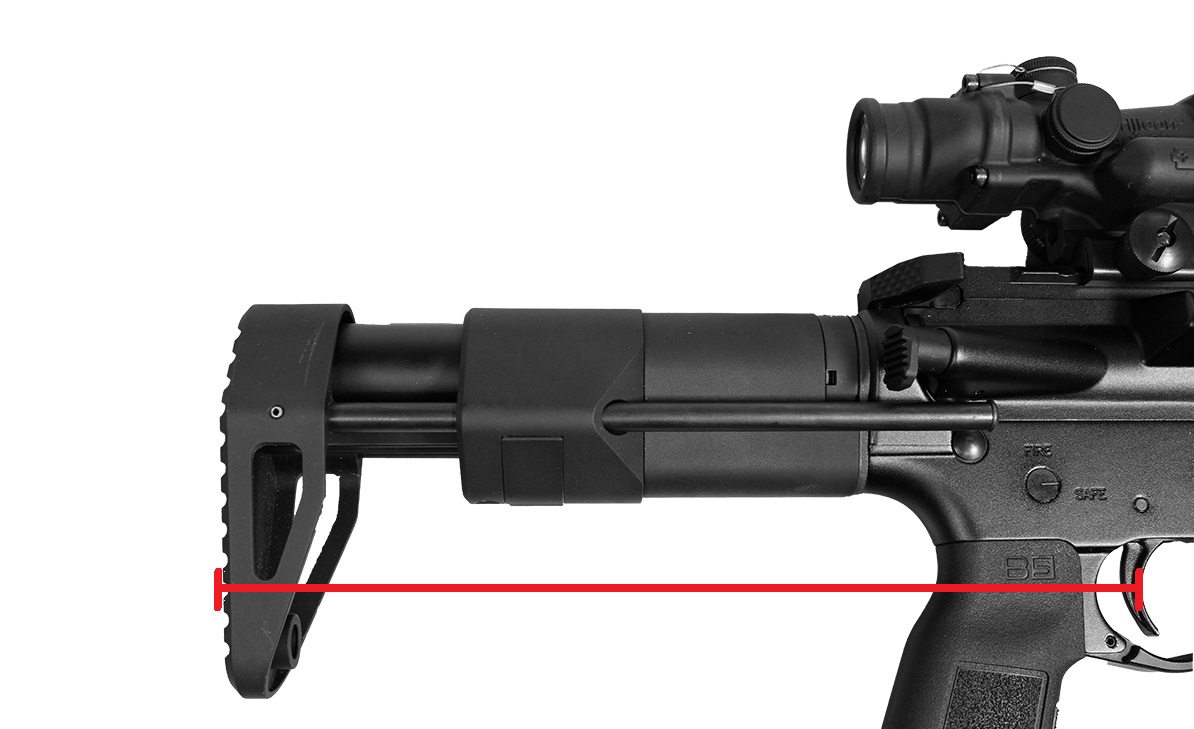How to Set Your AR-15 Stock to The Correct Length
Posted by Gunbuilders.com on Dec 10th 2024
The AR-15 is a terrifically accurate weapon. It is, in fact, arguably the most accurate semiautomatic rifle in wide circulation. But getting the most out of your AR requires setting up your rifle with the correct buttstock positioning and length of pull -- otherwise, your sight picture, grip, and recoil management will suffer. Here's how to set the length of your adjustable AR-15 stock. These instructions apply for all adjustable stocks.
What is Length of Pull?

Length of pull, or "LOP," measures the horizontal distance between the middle of the trigger, and the end of the buttstock. Adjusting length of pull is important -- getting it set correctly is what allows you to have a proper grip on your rifle with your supporting arm oriented correctly. This, in turn, fosters a more stable shooting position and helps situate your head to obtain a clear sight picture. If length of pull is too long, you'll be unstable behind the gun; a short length of pull will leave you feeling cramped behind the gun.
How to Set LOP on Your AR-15
There are two easy, simple tricks you can use to adjust your stock and set the optimal length of pull on your AR-15.
The "Bent Elbow" Method

This decidedly unscientific method requires no measuring tape, but it's arguably the most effective and quickest way to set length of pull.
Hold your shooting arm out to the side, like a chicken wing. Bent your elbow 90 degrees while holding the pistol grip of your rifle, as you would when ready to fire. Follow firearm safety rules, and keep your finger off the trigger.
While supporting the rifle, adjust the stock's length of pull so the butt of the stock is resting against the inside of the arm, next to the inside bend in your elbow, just below the bicep.
The Nose-to-Handle Method

Not all shooters' arm lengths will produce an optimal length of pull using the "bent elbow" method above -- and that's OK. The AR-15 provides a second simple but proven method for setting LOP using your individual frame.
Obtain a cheek weld atop the stock while sighting through the rifle's iron sights or optic. Place your nose one-half to one inch (0.5" to 1") from the charging handle, adjusting the distance as needed to achieve proper eye relief.
While maintaining this position, support the gun with your shooting arm and tuck the elbow close to the side of the chest. In this stance, adjust the stock's LOP until it is positioned against the shoulder.
Proper Buttstock Placement
The placement of the buttstock against the front of the body is important while setting the correct length of pull. Improper placement of the stock against the body will contribute to an inaccurate LOP that affords poor stability and a sub-optimal sight picture.
The buttstock should be as far toward the inside of the chest as possible, resting firmly atop the pectoralis major muscle -- the primary chest muscle. The stock should not rest against the anterior deltoid (the front shoulder muscle).
The stock should also not rest directly against the collar bone. Doing so will likely result in injury, including bruising or bone fractures.
Proper Shooting Stance
Maintaining a proper shooting stance while setting LOP is as important as stock placement. Maintaining a poor stance will result in obtaining an inaccurate length of pull measurement. While adjusting the stock, the shooter's legs should be spread shoulder width apart, with both feet parallel to one another, effectively drawing a perpendicular line relative to the rifle.
Standing with one foot far forward of the other while adjusting LOP will cause the chest to rotate, resulting in poor stock placement and an inaccurate measurement of the stock's length when making adjustments.
DISCLAIMER: If you are new to the world of DIY gun building, you likely have a lot of questions and rightfully so. It’s an area that has a lot of questions that, without the correct answers, could have some serious implications. At GunBuilders.com, we are by no means providing this content on our website to serve as legal advice or legal counsel. We encourage each and every builder to perform their own research around their respective State laws as well as educating themselves on the Federal laws. When performing your own research, please be sure that you are getting your information from a reliable source.

